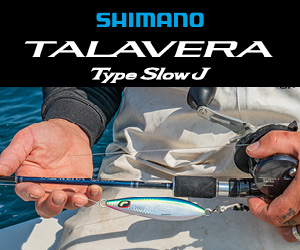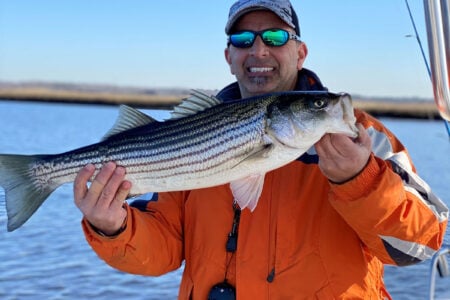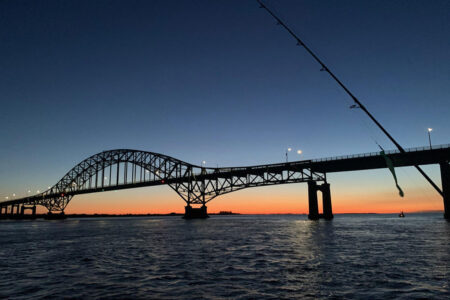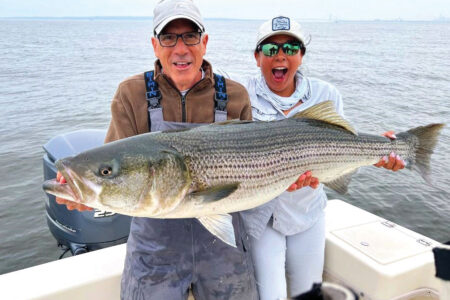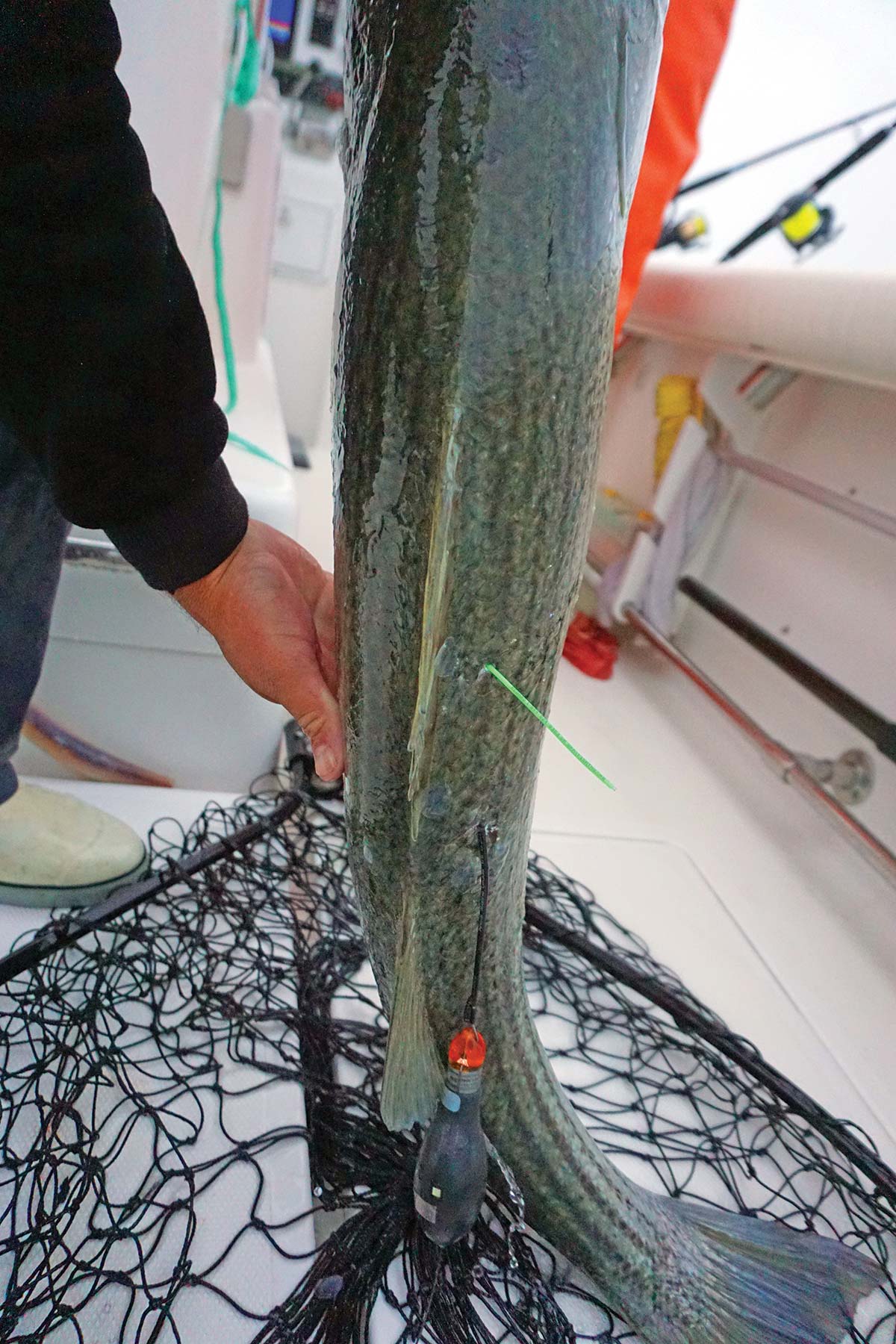
The 2023 rundown on the satellite tagging from three late season stripers in 2022.
Our February edition update (Northeast Striped Bass Study: Friends, Fathers, Sons & Striper Tags) on our 2022 tagging efforts with Gray Fishtag Research and the Northeast Striped Bass Study gave the rundown through the first half of 2022, as we deployed three satellite tracking devices into good-sized stripers, a 40-incher (Pappy Jim), and a pair of 48-inch stripers (Van Staal and Seaguar Striper).
In addition to the MiniPAT and mrPAT devices designed for larger 34-inch and over fish, the Washington-based Wildlife Computers also sent our team out with two new “field test” satellite tags over the summer of ’22 designed for smaller specimens, with one microPAT device placed in a 29-inch striper near the Verrazano Bridge, the second on a 32-inch striped bass off Massachusetts.
Five high-tech tags in all. Regrettably, the returns on these first deployments didn’t yield any quantifiable or qualified returns; while each was pre-programmed for a set period of a few months before becoming disengaged from their host fish, most “popped” free too early to provide any substantive results, a few others never to be heard from again.
“Satellite tagging research efforts comes with risk as we place an object on a live animal in its natural environment,” said Roxanne Willmer from Gray FishTag Research, adding “They are subject to angler involvement, premature shedding, and predator attack.”
More on “predator attacks” in a moment, but first, the second half of our ’22 story!
A Fish Called Berkeley
On Tuesday, October 25, 2022, my father and I hopped aboard Chuck Many’s Tyman out of Highlands, NJ with the $5,000 MiniPAT device locked tight in a watertight case. A few hours and several high fives later, a 42-inch striper named in honor of Northeast Striped Bass Study supporters Berkeley Striper Club was set free just east of Sandy Hook at the Jersey Shore (40° 25.855 north by 73° 55.314 west) with that device implanted along her shoulder flank and set to stay in place for 120 days. That MiniPAT device as we’ve written extensively here at The Fisherman since 2019 is designed to archive data on water temperature, pressure and light conditions in onboard memory contained within the tag.
Back on February 23 of this year I received an email from Roxanne Willmer at Gray FishTag Research that said the tag was active and transmitting data to the Argos satellite overhead. “It is currently reporting offshore of Assateague Island National Seashore in Maryland at a LAT/LON of 38° 1.380 north by 74° 37.920 west,” Willmer said, putting that first satellite feed about 27 nautical miles offshore and approximately 148 miles south of where it was initially caught, tagged and released. To draw a direct line between those two points you would essentially run ashore from Seaside to Surf City along the Central Jersey coast, before venturing beyond the three-mile-line someplace off of Beach Haven and beyond. But where the tracking started and where it all ended is only part of Berkeley’s story.
November of 2022 will most likely be remembered as one of the most epic striped bass runs of all time from the NY Bight down along the North Jersey coast. For boats and surfcasters alike, the sheer number of stripers caught into December was staggering; best explanation for the solid bite was that young-of-the-year menhaden pouring out of Raritan Bay and Jamaica Bay estuaries kept the stripers around for an extended period of time to feast before their journey to wintering grounds. Many agrees, adding “My feeling is she stayed there just because we had so much bait. It’s almost if the amount of bait changed its migration.”
And according to the data inside that MiniPAT device, like much of the striped bass of November, Berkeley didn’t leave the NY Bight right away. In fact, according to the light, depth and temperature data that was fed to the Argos satellite during a two-week span of the tag’s battery life, it appears as if Berkeley zigged and zagged from the Raritan out to Long Island, up into the Raritan Bay and lower New York Harbor before heading back outside of the Raritan another two months.
I remember vividly the final day of epic blitzes in the northern half of the Jersey Shore above Barnegat Inlet; it was Sunday, December 4. That next Monday morning, there was mostly a pick of fish along local beaches for the rest of the month, though boats continued to find pretty solid action right up through the holidays. “Thought maybe striper fishing was done, not the case,” said Capt. Ralph Leyrer of Last Lady Fishing Charters out of Shark River Inlet on Sunday, December 18 for our North Jersey reports in The Fisherman. That morning, Ralph reported 28 fish total caught, with five slot fish and 10 overs. Like other Jersey Shore captains, he kept targeting the stripers into the New Year.
And it wasn’t until the calendar flipped on that year that was, that Berkeley finally began to make her move to the south. According to the tracking data uploaded to the Argos satellite, Berkeley stayed offshore in the exclusive economic zone (EEZ) from what appears at times to be from 10 to 30 miles from shore at some points, moving rather quickly down the Central and South Jersey coast (which also corresponds with our regional fishing reports), bypassing Delaware Bay before spending a great deal of time during February off the coast of Maryland.
Again, looking at the fishing reports compiled for our New Jersey, Delaware Bay edition that seems to mesh. “Moseying on down,” is how our South Jersey Field Editor Anthony Califano put it in his January 1 report to The Fisherman. “With plenty of action north of Barnegat Inlet in November and December, South Jersey is finally getting to wet their beak,” he reported to end the year, adding that pop-up action a mile or two outside was keeping boaters hooked up. “Trolling the lumps and casting swim shads under working birds has produced fish from 28 to 45 inches through the end of December,” Califano noted.
Because of the 27-mile or so distance from shore when the MiniPAT popped free and first began uploading data to the satellite, it seems rather hard to imagine this device ever being retrieved again; but that’s not to say that it won’t be. The one big question I have personally about this fish called Berkeley and the data she shares is that because of the final location of the tag in between the Chesapeake and Delaware Bay, we may never know where her eventual arrival was as a spawning class fish.
“Was she going to beeline to the Chesapeake in the next few weeks to spawn or head north to enter the Delaware or Hudson,” Many pondered by phone as we reviewed Berkeley’s apparent chart, wondering if maybe she wasn’t even going to spawn at all this year, “because she is too far away and conditions won’t be right,” Many noted, adding “So many unanswered questions.”
Considering the presence of large spawning stripers in the upper stretches of the Chesapeake by late February of ‘23, one has to wonder where Berkeley’s next zig and zag would occur from her last position nearly 50 miles southeast of the Delaware Bay entrance, and 85 nautical miles northeast Cape Chares, VA.
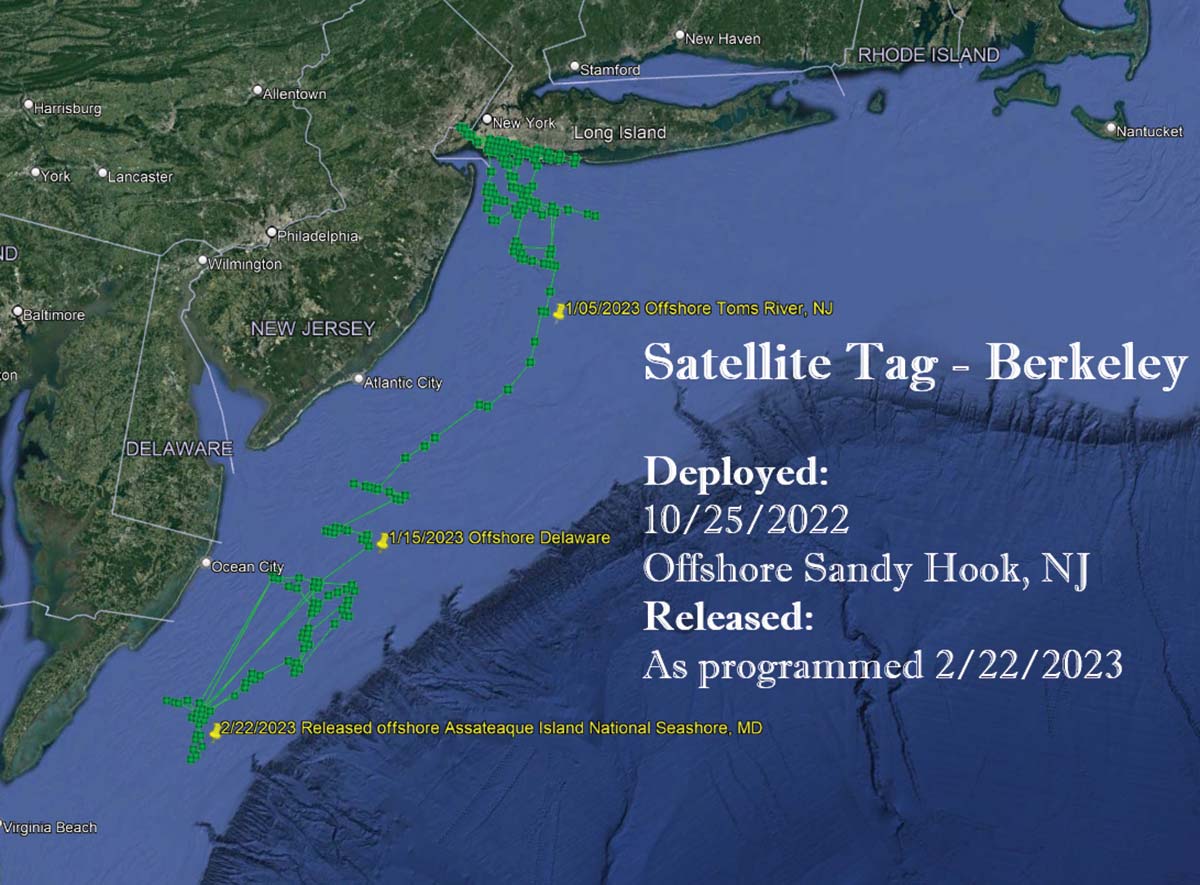
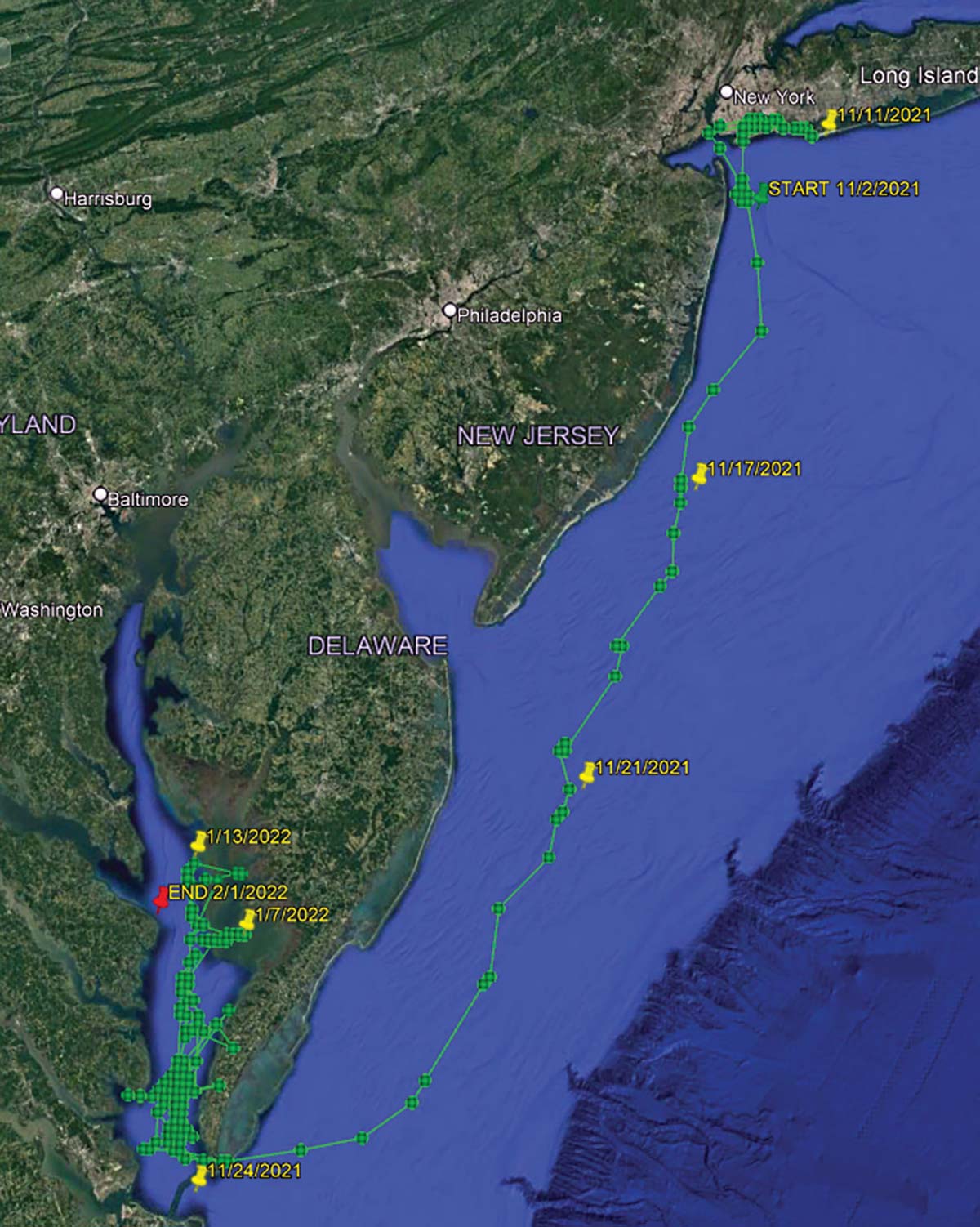
Chesapeake Tagging
Not long after the Jersey Shore deployment of Berkeley in October, Many pulled Tyman for the winter and headed south down the DELMARVA Peninsula to fish with Capt. Clint Lessard of Sho Nuf Sportfishing on his favorite winter trophy striper hunting grounds out of Cape Charles, VA. On December 10 and 11, two more MiniPAT devices were deployed in jumbo stripers that were already up inside the Chesapeake Bay, one fish named Tyman and the other named Marlin Maniac. Regrettably, the fish named Tyman deployed on December 10 released prematurely after just three weeks.
As soon as that MiniPAT device began its uplink to the Argos satellite, the team from Gray Fishtag Research got on the phone with contributor Dave Nova to send out a special satellite tag receiver to help search for the device. “His friend Sammy spoke with GFR (Gray Fishtag Research) advisory board member, Chris Scanzillo, for some insight in how to use the receiver,” Roxanne said on January 17, adding “Sammy had the last GPS uplink transmission coordinates provided from the tag before it went offline, the receiver, a skiff boat, cold temperatures, and winds in the high 20’s with gusts of 30 as he ventured out Sunday.
“Once Sammy arrived at the location the receiver did not pick up any communication from the tag, so, he pulled up the coordinates and decided he would try to look for it without the receiver,” Roxanne recalled, adding “With the coordinates he had he literally walked right up to the tag and sent a text to the team.”
| STUDY SPONSORS |
| The ongoing Northeast Striped Bass Study partnership with Gray Fishtag Research and The Fisherman would not be possible without the incredible financial support of our sponsors, including American Fishing Wiring (AFW), Berkeley Striper Club, Caterpillar Marine, Fin-Nor, the Fisheries Conservation Trust, Hudson River Fishermen’s Association, LBI Surf Fishing Classic, the Many, Glassberg and Nova families, Montauk Surfcasters Association, New York Sportfishing Federation, PENN, Raritan Bay Anglers Club, Reel Max Life / NJ SAT Fest, Ross Brewery, Seaguar, Simrad, Southernmost Apparel, Yo-Zuri, and Van Staal. |
This is the second GFR satellite tracking device that Sammy has found for the project. Regrettably, because of the short amount of in-water time, there’s not a lot of information that can be gleaned from this MiniPAT. But it was the first tag retrieved during the Northeast Striped Bass Study since we began in 2019 to have clear bite marks. “This tag definitely shows that something got a hold of it,” Roxanne said.
That’s not to say that a predator got a hold of the striper; it is possible of course. Also possible is that an otter picked it up after the tag released from the striper. What we do know is that if a larger predator had consumed the fish with the tag, the light and temperature data stored inside the device should bear that out. What we are realizing though as a team after several attempts to deploy MiniPAT devices into jumbo stripers in the lower Chesapeake during late fall and early winter is that this region presents challenges.
On December 11, Many and fellow Gray Fishtag Research contributors Dave Nova and tagging partner Capt. Lessard aboard Sho Nuf Sportfishing deployed another MiniPAT satellite tag on a 45-1/2-inch striped bass named Marlin Maniac off Cape Charles, VA in the Chesapeake Bay. “Our goal was to study the migration for a three-month period,” Willmer said, adding that the tag remained intact for the full duration and released as programmed on March 12, 2023 somewhere along the Nanticoke River in a marshy, rural area not easily accessible by foot.
“For days as the tag was transmitting its stored data to Argos, we were receiving reliable GPS uplink locations, so we were confident in tags general location,” Willmer said, explaining how she stay in touch regularly with Nova and even sent a satellite tag receiver from Wildlife Computers to assist in his efforts.
On Sunday, March 19, Nova and his brother took the 9-hour road trip and spent a few hours looking for the tag with the receiver. “Dave was getting strong indications that he was in the right place; however, he could not narrow down the exact location,” Willmer said later. The receiver has a tremendous learning curve and after Nova returned home he got in touch with Gray Fishtag Research Advisory Board member Chris Scanzillo who had first-hand experience with the unit. However, before Nova could get back out again for another search, the MiniPAT device stopped connecting to the Argos.
“This could mean that the internal battery died sooner than we expected or that the tag’s antenna is now obstructed and not able to connect,” Willmer explained later. Nova and three friends took a 40-mile trip by water in a skiff later in hopes of finding the device, but had no luck.
While the MiniPAT device was not physically retrieved, as with the fish named Berkeley there was information uploaded to the Argos that could be processed. It’s late March as I’m putting this together, and we hope to have more information on Marlin Maniac and perhaps Tyman to publish in an upcoming edition of The Fisherman this summer.
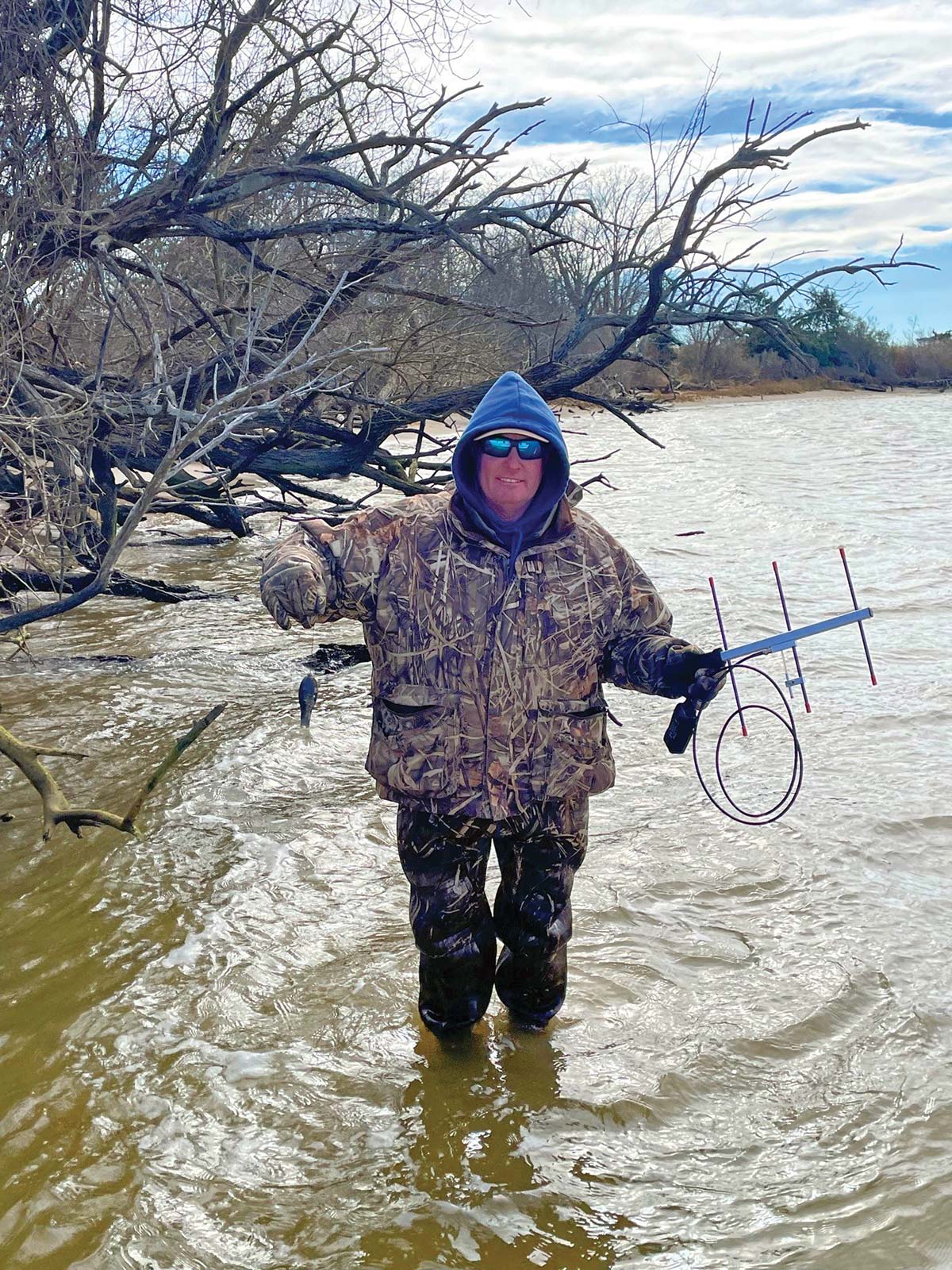
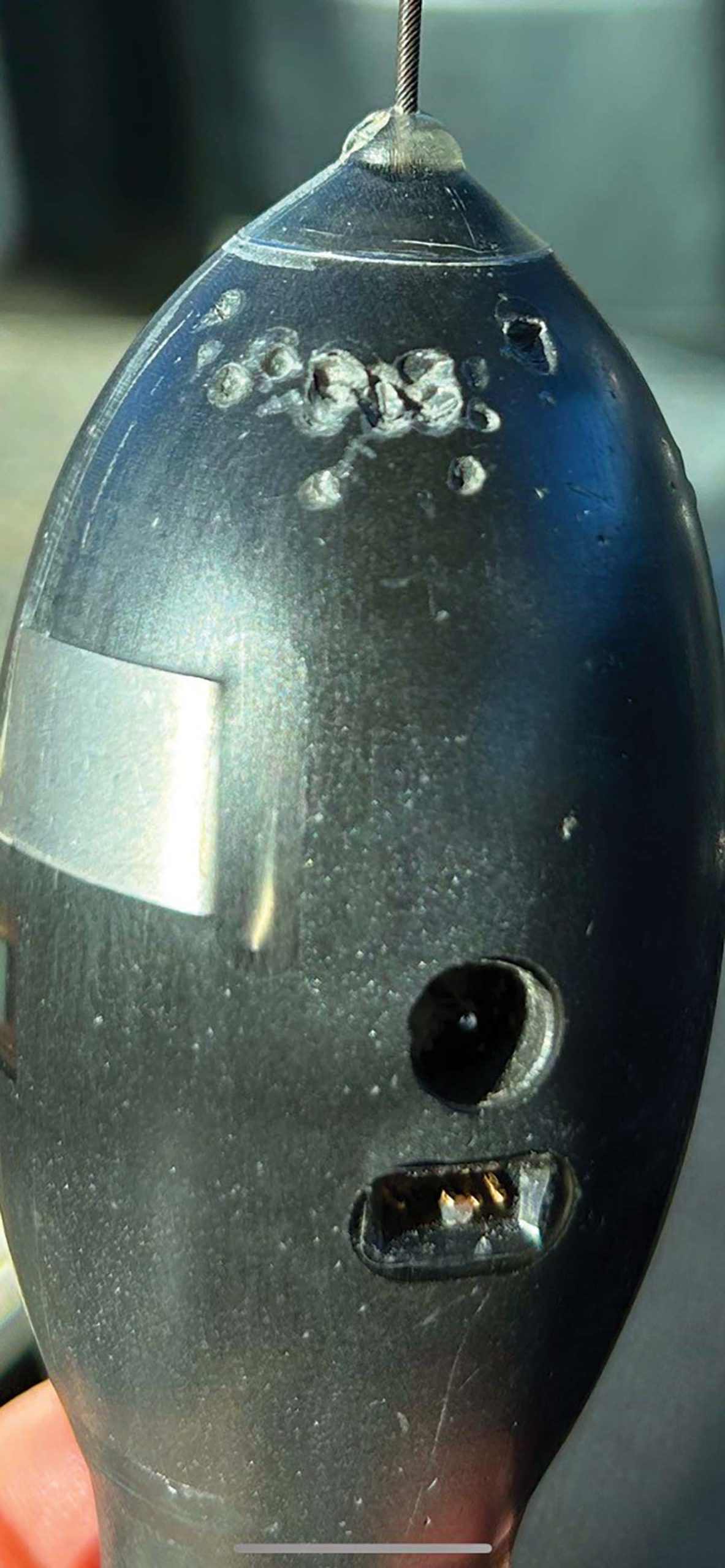
Striper Quest ‘23
On Thursday, May 18, our Northeast Striped Bass Study team and all of our sponsors will return to the Raritan Bay for another round of satellite tagging with jumbo striped bass. If you’re out and about in the hunt for striped bass yourself in the Sandy Hook area, local charter boats including Fin Chasers, Twin Rivers Charters, Krunch Sportfishing, Andreas Toy Charters and Sherri Berri will be mixing it up on the striper grounds with the crews from Tyman, Critter Catcher and others in Striper Quest 2023. In addition to the deployment of a new round of MiniPAT devices, our study sponsors and supporters will tagging stripers with GFR streamer tags.
“To date, our striped bass research efforts have been an amazing study with daily interest from local captains, mates, and recreational anglers getting involved to support our GFR green spaghetti tagging initiatives,” Willmer said, noting that in 2021 and 2022 striped bass became the “top tagged species” globally for the Gray Fishtag Research non-profit research program.
“Each year, our mission is to expand our Northeast research efforts to collect more data,” Willmer went on to explain, adding that the GFR program is at the forefront of striped bass satellite tagging studies and gathering some rather groundbreaking data collection. She added, “The goal of our work is to gain a greater understanding of the migration and behavior pattern of this well sought-after species.”
If this study is interesting to you; if you’d like to see more research like this; and if you believe that gathering more data about striped bass migration is important, then we hope you could come aboard. For a $25 tax-deductible charitable donation to Gray Fishtag Research, you’ll receive a custom decal from marine artist Carey Chen that allows you to show your support for the Northeast Striped Bass Study. Contact Roxanne Willmer at 844-824-8353 or [email protected] or go to www.grayfishtag.org.
